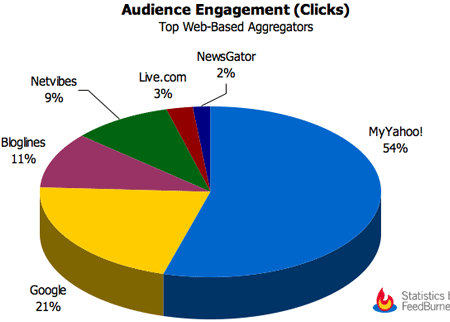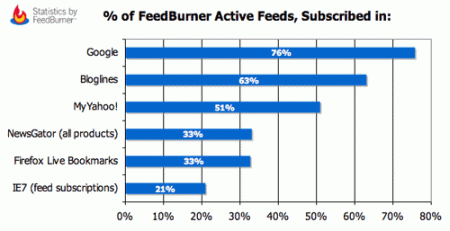Detailed statistics on RSS aggregators
A week ago, Google Reader developers revealed information about the number of subscribers to each RSS feed. The numbers are not yet shown in the Google Reader interface, but they are in the crawler's “user-agent” header.
The largest blogs immediately reported that, taking into account the new data, their audience grew by 20–60%. In the blogosphere, a whole wave of speculation has risen, which RSS aggregator is the most popular. Previously, the most popular were My Yahoo! and Bloglines , and now it turns out that Google Reader is much more popular than Bloglines. However, no one had exact statistics. Now she has appeared.
Analytical company FeedBurner has published accurate statistics on the share of RSS-aggregators on the Internet. When analyzing data, you need to understand that RSS aggregators report different numbers on the number of their subscribers. For example, My Yahoo! for each feed, it gives the number of active subscribers over the past 30 days , while most other RSS aggregators report the total number of subscribers (no matter how long they visited the site), and Google, in addition, adds the number of users “personalized pages of Google Personalized Homepage.
The FeedBurner statistics account for 604,533 feeds from 347,000 authors / publishers. Every day, users download content with over 3000 different clients.
')

By the number of clicks, the undisputed leadership belongs to the aggregator My Yahoo !, and Google Reader took the second place.
True, my Yahoo! can not be called a full-fledged aggregator, because it does not display the content of feeds, but only gives out headlines, and for the full text sends users to sites with original text. Accordingly, there is no full-text search and many other functions. However, my Yahoo! remains the main traffic generator for publishers. By the number of transitions, the four largest aggregators (My Yahoo !, Google Reader / Personalized Homepage, Bloglines and Netvibes) control 95% of the market.
If you build the same table by the number of views of feeds, then My Yahoo! with the absence of such a function remains out of work. This diagram shows only “clean” RSS aggregators, excluding widgets and client programs.

Considering how Google Reader nonstandard renders HTML , the figure of 59% can be called a very conservative estimate. After all, their rendering (and the reflection in the statistics) occurs only for messages on the screen, while the other aggregators draw the entire HTML page at once for many dozen screens ahead.
The Google Reader championship is confirmed by another statistical parameter: the share of active feeds FeedBurner, for which there are subscribers in one or another RSS-aggregator.

The largest blogs immediately reported that, taking into account the new data, their audience grew by 20–60%. In the blogosphere, a whole wave of speculation has risen, which RSS aggregator is the most popular. Previously, the most popular were My Yahoo! and Bloglines , and now it turns out that Google Reader is much more popular than Bloglines. However, no one had exact statistics. Now she has appeared.
Analytical company FeedBurner has published accurate statistics on the share of RSS-aggregators on the Internet. When analyzing data, you need to understand that RSS aggregators report different numbers on the number of their subscribers. For example, My Yahoo! for each feed, it gives the number of active subscribers over the past 30 days , while most other RSS aggregators report the total number of subscribers (no matter how long they visited the site), and Google, in addition, adds the number of users “personalized pages of Google Personalized Homepage.
The FeedBurner statistics account for 604,533 feeds from 347,000 authors / publishers. Every day, users download content with over 3000 different clients.
')

By the number of clicks, the undisputed leadership belongs to the aggregator My Yahoo !, and Google Reader took the second place.
True, my Yahoo! can not be called a full-fledged aggregator, because it does not display the content of feeds, but only gives out headlines, and for the full text sends users to sites with original text. Accordingly, there is no full-text search and many other functions. However, my Yahoo! remains the main traffic generator for publishers. By the number of transitions, the four largest aggregators (My Yahoo !, Google Reader / Personalized Homepage, Bloglines and Netvibes) control 95% of the market.
If you build the same table by the number of views of feeds, then My Yahoo! with the absence of such a function remains out of work. This diagram shows only “clean” RSS aggregators, excluding widgets and client programs.

Considering how Google Reader nonstandard renders HTML , the figure of 59% can be called a very conservative estimate. After all, their rendering (and the reflection in the statistics) occurs only for messages on the screen, while the other aggregators draw the entire HTML page at once for many dozen screens ahead.
The Google Reader championship is confirmed by another statistical parameter: the share of active feeds FeedBurner, for which there are subscribers in one or another RSS-aggregator.

Source: https://habr.com/ru/post/5074/
All Articles